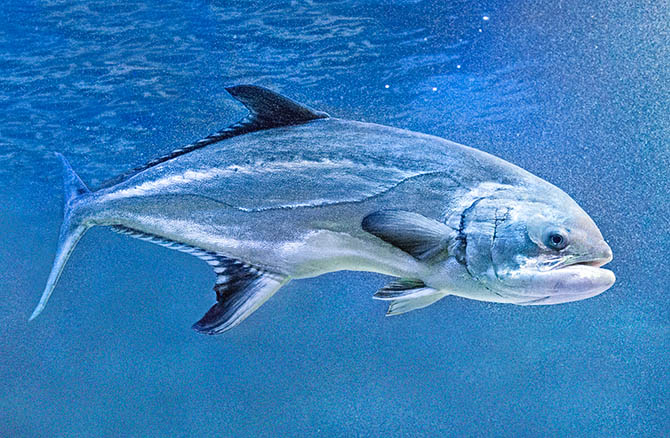Family : Carangidae

Text © Giuseppe Mazza

English translation by Mario Beltramini
The Leerfish (Lichia amia Linnaeus, 1758) belongs to the class of Actinopterygii, the ray-finned fishes, to the order of Perciformes and to the family of Carangidae.
The name of the genus appears to have a French origin. Already in 1410 they were talking of a fish “lecha” particularly greedy (it should come from the verb “lecher, être gourmand” = that is, literally, to lick, to be greedy).
The name of the species “amia” is the epithet with which the old Greeks designated a big fish as greedy as a shark. The name was zoologically taken by Linnaeus himself for creating the genus Amia which has only one member, the Amia calva, a North American fresh water fish, living fossil of an old stirp.
Hence, going back to our leerfish, this is a big greedy fish.
Zoogeography
The leerfish is present in all the Mediterranean, Black Sea included, where however its number is scarce, as also is the case of the eastern coasts from Libya to Turkey. After Gibraltar Strait, we find it northwards, with a good density of population, up to the Gulf of Biscay. South of Gibraltar, with variable densities, it goes along African coasts, after having colonized the Azores, Madeira, Canary and Cape Verde islands, and then moves northwards in the Indian Ocean reaching western India.
Ecology-Habitat
It is a pelagic erratic species, which usually does not go down below the 50 m, but which gets close to the coasts only in spring for reproducing. It has been found also in brackish waters.

The Leerfish (Lichia amia) has a very vast diffusion. It can reach the 2 m and the 50 kg © Giuseppe Mazza
Morpho-physiology
It can be 2 m long with a maximum weight of 50 kg, but the fished specimens rarely exceed the metre.
The body, very compressed on the sides, is covered by tiny scales, almost invisible, but the most striking matter is the quite unusual path of the lateral line, going down and then ascending again thus drawing a sort of an “U” at the centre. The snout is pointed, with an ample mouth and the lower jaw slightly protruding. The teeth, thin and tiny, are placed in rows on the jaws, and cardiform on the vomer, the palatines and the tongue. The eye is of modest size.
The dorsal fins are two and follow the architectural scheme of the Pompano (Trachinotus ovatus).
The first is preceded by an independent spine, bent towards the head, and has 7 short spines looking towards the tail, which fold when swimming in a dedicate lodging. The second dorsal fin has one spiny ray and 20-21 unarmed ones. The anal, preceded by two foldable spines looking towards the tail and ending in a ventral groove, has 20-21 soft rays. We must note that the second dorsal as well as the anal fins have the tip elongated in the oldest specimens. The caudal fin is much forked; the pectoral ones are of modest size, like the ventral.
The colour is silvery grey, paler on the sides and darker on the back, which may assume also greenish hues. The tips of the fins are dark.
Ethology-Reproductive Biology
The leerfish is a fast fish hunting schools of fishes and molluscs. The juveniles, who have vertical bands, prefer, on the contrary, the crustaceans. Little is known about the reproduction which takes place in spring. After some, the eggs should be spawned on the stones, bonded with some mucus, after others, they are simply pelagic.
The vulnerability index of this species is of 75 over 100.
Synonyms
Scomber amia Linnaeus, 1758; Caesiomorus amia (Linnaeus, 1758); Caranx amia (Linnaeus, 1758); Hypacantus amia (Linnaeus, 1758); Centronotus vadigo Lacepède, 1801; Campogramma vadigo (Lacepède, 1801); Scomber flexuosus Lichtenstein, 1823; Porthmeus argenteus Valenciennes, 1833.
→ For general information about FISH please click here.
→ For general information about BONY FISH please click here
→ For general information about CARTILAGINOUS FISH please click here.
→ To appreciate the BIODIVERSITY of BONY FISH please click here.
→ To appreciate the BIODIVERSITY of CARTILAGINOUS FISH please click here.
